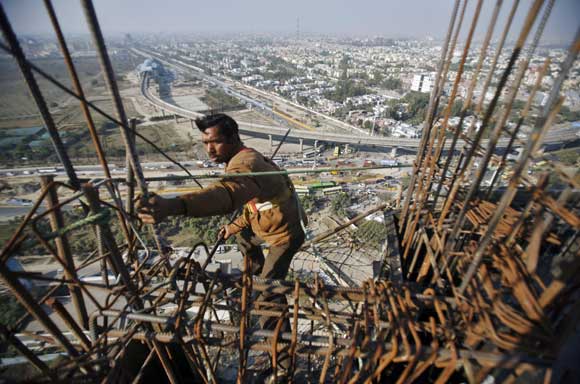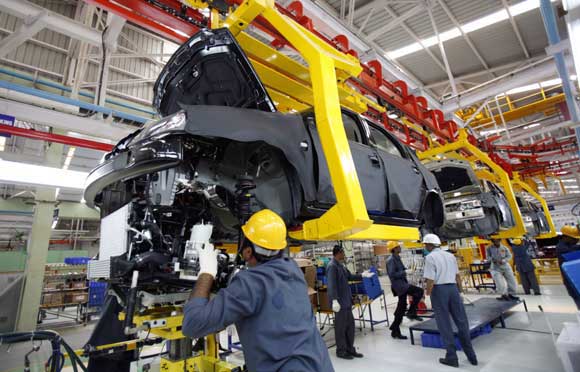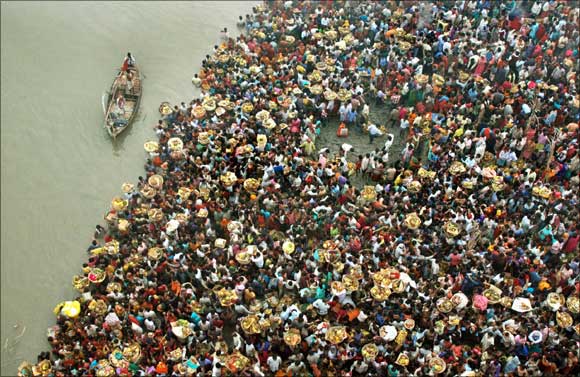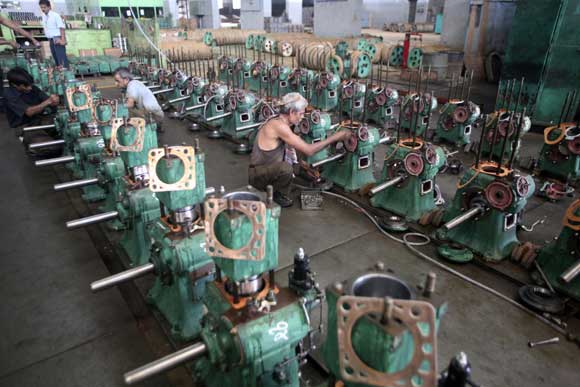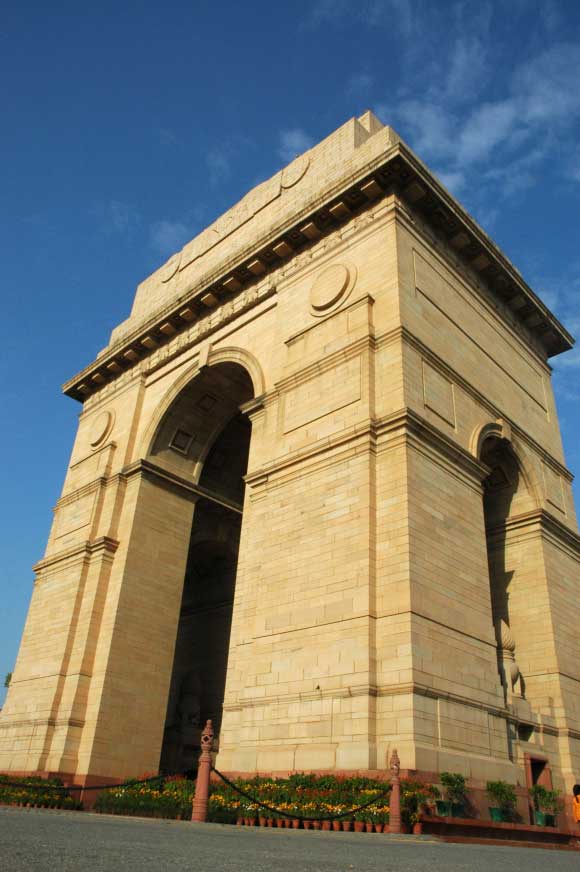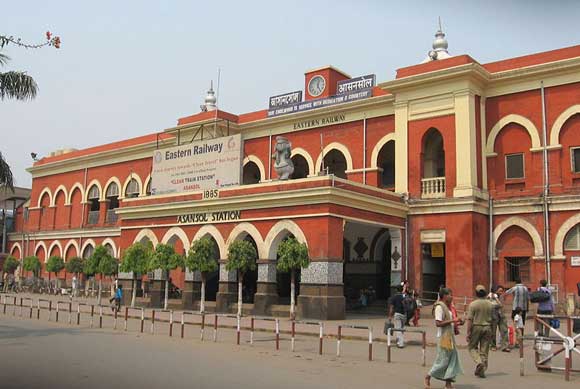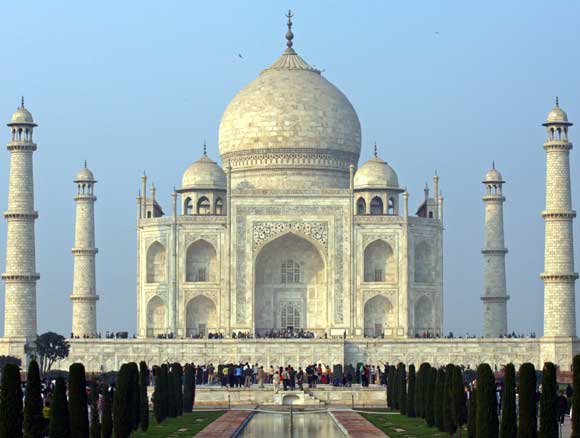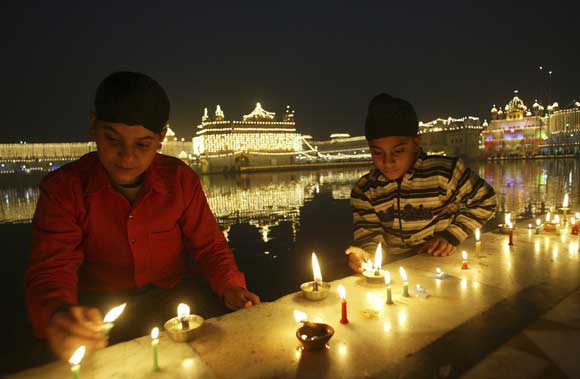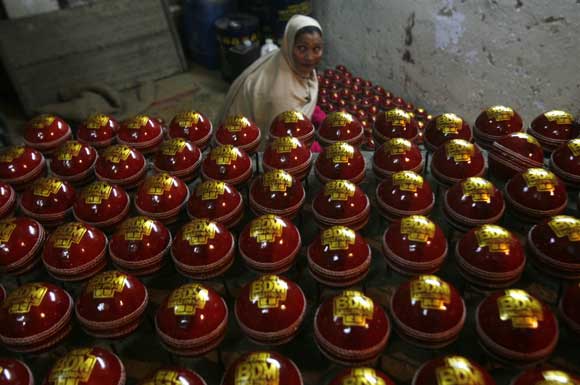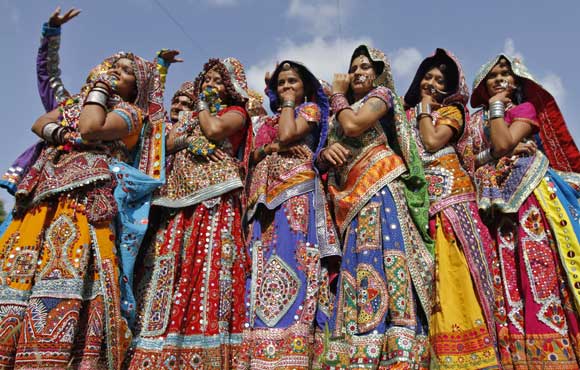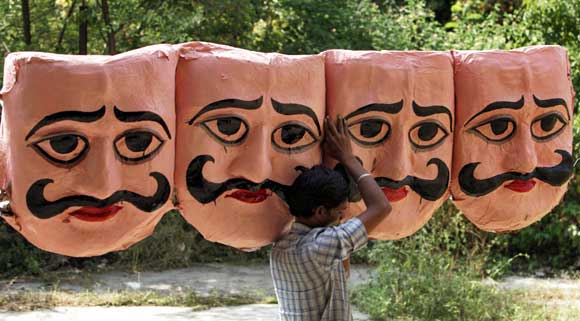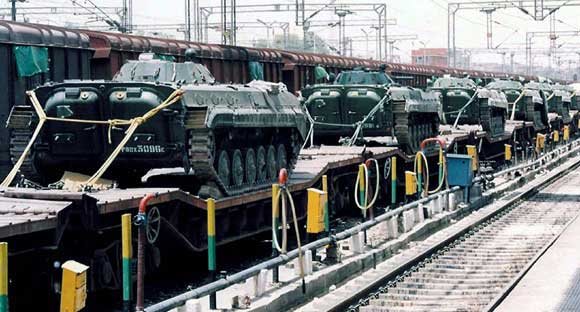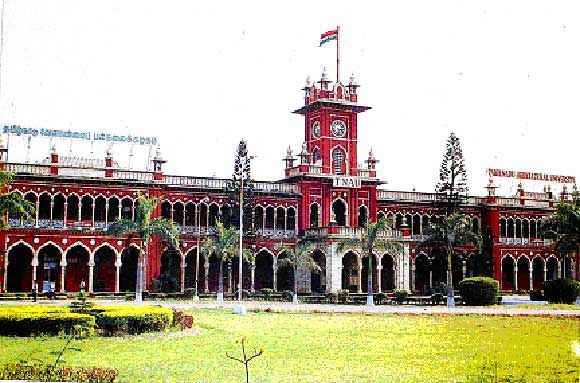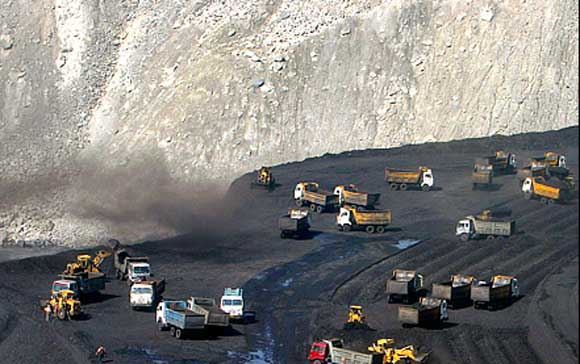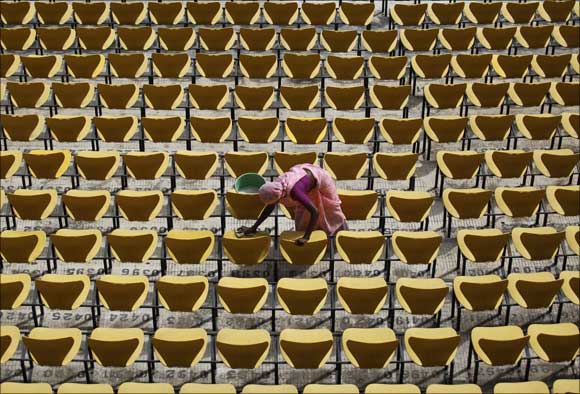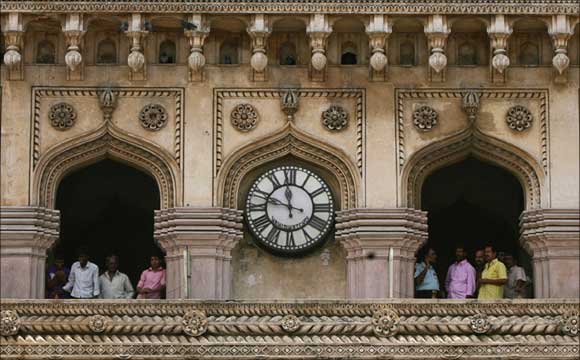 | « Back to article | Print this article |
The FASTEST growing cities in India
There are 37 Indian cities among the world's 300 fastest growing urban centres, according to a survey conducted by the City Mayors Foundation, an global think tank on urban affairs.
Beihai in China is the fastest growing city in the world, with a population growth rate of 10.58 per cent, says the survey. Sana'a in Yemen, with a population growth rate of 5 per cent, is the world's third fastest growing city.
Kabul in Afghanistan (4.74 per cent), Bamako in Mali (4.45 per cent), Lagos in Nigeria (4.44 per cent) are the 5th, 6th and 7th fastest growing urban centres in the world. Dar es Salaam in Tanzania (4.39 per cent) and Chittagong in Bangladesh (4.29 per cent) are the 9th and the 10th fastest growing cities in the world.
The economic boom has been a catalyst for the fast-track development across India. The nation's development has now shifted from the big metropolitan cities to the smaller cities where the cost of living is much lower and the quality of life far better.
Also with small cities offering better infrastructure, better work-life balance and lucrative jobs, the boom is evident. Although there's still some way to go for smaller Indian cities to be counted amongst India's best, they have already caught up with (in some case even beaten), the bigger ones in terms of fast-paced development and urbanization.
So which are India's fastest growing cities according to City Mayors? Click NEXT to find out . . .
The FASTEST growing cities in India
1. Ghaziabad
Almost cheek by jowl to New Delhi, Ghaziabad is the fastest growing Indian city and the second fastest growing city in the world, according to the City Mayors study.
A rapidly expanding and industrially booming city, Ghaziabad is home to some of the world's best and biggest shopping malls and multiplexes.
The construction boom in Ghaziabad is nothing short of phenomenal.
Ghaziabad's average annual population growth rate: 5.20%
Click NEXT to read on . . .
The FASTEST growing cities in India
2. Surat
The City Mayors Foundation has ranked these cities assuming annual growth rates for urban areas between the years 2006 and 2020. The study places special emphasis on growth/decline in the past and forecasts for the future made by international and national statistical organisations.
Surat, India's diamond city, is India's second-fastest and the world's fourth-fastest growing city.
Surat average annual population growth rate: 4.99 per cent
Click NEXT to read on . . .
The FASTEST growing cities in India
3. Faridabad
The largest city in Haryana, Faridabad is the major industrial hub of the state. According to reports, the city accounts for half of the income tax collected in the state and about 60 per cent of Haryana's revenue.
Faridabad, says City Mayors, is India's 3rd fastest growing city and the eighth fastest growing urban centre in the world.
Faridabad's average annual population growth rate: 4.44 per cent
Click NEXT to read on . . .
The FASTEST growing cities in India
4. Nashik
Nashik, the 'wine capital of India', is located about 200 km from Mumbai. It has been ranked as India's fourth fastest growing city and the 16th fastest growing in the world.
The city's demographics make it ideal for the services sector boom that it is experiencing. The industrial sector too is growing rapidly in Nashik.
Nashik's average annual population growth rate: 3.90 per cent
Click NEXT to read on . . .
The FASTEST growing cities in India
5. Patna
Patna, the capital of Bihar, is a major agricultural hub with its production of foodgrain, sugarcane, rice, etc making it one of the major exporting centres.
Under the new government, headed by Chief Minister Nitish Kumar, the state has seen rapid growth and Patna, by far, has been one of the biggest benefactors of this thrust on development.
In 2009, the World Bank ranked Patna as the second best city in India to start up a business. The city also has lowest slum population of any city in India.
Patna is India's 5th fastest growing city and the 21st fastest growing city in the world, according to the study.
Patna's average annual population growth rate: 3.72%
Click NEXT to read on . . .
The FASTEST growing cities in India
6. Rajkot
Rajkot, one of the largest cities in Gujarat, is the nation's 6th fastest growing city. It has been ranked by City Mayors as the 22nd fastest growing urban area in the world.
Rajkot's average annual population growth rate: 3.63%
Click NEXT to read on . . .
The FASTEST growing cities in India
7. Jaipur
Jaipur is India's 7th fastest growing city and the 24th fastest growing urban centre in the world, according to the City Mayors study.
The capital of Rajasthan, Jaipur is a major hub for traditional and modern industries. It has a booming gems and jewellery industry and is one of the largest exporters of gold, diamond and stone jewelery in Asia. It is also coming up as a major ITES centre, apart from handlooms, textiles, readymade garments, and carpets.
It has been ranked 31st among the 50 Emerging Global Outsourcing cities.
Jaipur's average annual population growth rate: 3.60 per cent
Click NEXT to read on . . .
The FASTEST growing cities in India
8. New Delhi
Though it doesn't currently rival Mumbai in terms of contribution to the growth of the Indian economy, the capital of India, is no pushover.
New Delhi has been ranked as the 8th fastest growing city in India and the 28th fastest growing urban centre in the world.
Delhi GDP stands at about Rs 1,60,739 crore (Rs 1,607.39 billion). It contributes 4.94 per cent to all-India GDP.
Being an important commercial centre in South Asia, Delhi has a per capita income of Rs 53,976, which is more than double the national average.
Delhi's key service industries, backed by as strong and well laid out infrastructure, include IT, telecommunications, hotels, banking, media and tourism. In recent times, Delhi's manufacturing industry has grown considerably and consumer goods industries have established manufacturing units and headquarters in and around the capital.
New Delhi's average annual population growth rate: 3.48 per cent
Click NEXT to read on . . .
The FASTEST growing cities in India
9. Pune
The growth of this major industrial city, located roughly 170 km east of Mumbai, has a booming economy.
Pune, India's 9th fastest growing city, has been ranked as the world's 29th fastest growing urban centre.
Starting from automobile majors like Tata Motors, DaimlerChrysler, Pune will soon house units of global biggies like General Motors, Volkswagen, Fiat, et cetera. A number of important engineering goods industries like Cummins Engines Co Ltd and Bharat Forge Ltd, electronic goods companies like LG, Whirlpool, food companies like Frito Lay and Coca Cola are also located here.
Of late, Pune's software industry has grown by leaps and bounds. IT parks like Rajiv Gandhi IT Park at Hinjewadi, Magarpatta Cybercity, MIDC Software Technology Park at Talawade, Marisoft IT Park at Kalyani Nagar are seats of technology that the city can boast of.
To meet the demands of this explosive economic growth in Pune, the state of Maharashtra is planning a 1,000 MW power plant to exclusively cater to the need of Pune. MIDC is the lead agency for the project.
Pune's average annual population growth rate: 3.46 per cent
Click NEXT to read on . . .
The FASTEST growing cities in India
10. Indore
Indore, the commercial capital of Madhya Pradesh, is home to hundreds of small-scale and large-scale manufacturing and industrial units in areas of automobiles, pharmaceuticals and textiles.
It is the 10th fastest growing city in India and the world's 32nd fastest growing urban centre.
A major trading hub, it also has a rapidly growing presence in software, retail and real estate sectors.
Indore's average annual population growth rate: 3.35 per cent
Click NEXT to read on . . .
The FASTEST growing cities in India
11. Asansol
Asansol in West Bengal is one of the busiest trading centres in India.
It is the 11th fastest growing city in India and the world's 42nd fastest growing urban centre.
It is a coal mining hub, and has a swiftly growing industrial arena.
The city boasts of a huge workforce with its per capita income being much higher than many Indian cities.
Asansol's average annual population growth rate: 3.11 per cent
Click NEXT to read on . . .
The FASTEST growing cities in India
12. Agra
Agra, the home of the Taj Mahal, is a major centre of small-scale industries and a growing hub for hospitality.
It is the 12th fastest growing city in India and the world's 53rd fastest growing urban centre.
It is ideal for business in small-scale industries, education centre, tourism, hospitality, biotech, textile exporting, automobile, and real estate.
Agra has some of the finest hotels and spas in India. It has Uttar Pradesh's first plant biotech company, Harihar Biotech.
It is also an important market for the automobile industry.
Agra's average annual population growth rate: 2.93 per cent
Click NEXT to read on . . .
The FASTEST growing cities in India
13. Amritsar
It is the 13th fastest growing city in India and the world's 6oth fastest growing urban centre.
Amritsar has been experiencing rapid growth in the last few years, with billions of rupees being poured into the development of its infrastructure, etc.
One of Punjab's largest cities, Amritsar has also seen a major boom in the real estate arena.
Amritsar's average annual population growth rate: 2.85 per cent
Click NEXT to read on . . .
The FASTEST growing cities in India
14. Meerut
Meerut is a major industrial city in Uttar Pradesh, but it also has a booming agricultural sector.
The city houses hundreds of small- and medium-scale industries.
It is the nation's 14th fastest growing city and the world's 63rd fastest growing centre.
Meerut's average annual population growth rate: 2.83
Click NEXT to read on . . .
The FASTEST growing cities in India
15. Bangalore
The capital of Karnataka, Bengaluru is also called the Silicon Valley of India. Hundreds of major IT corporations, both home-grown giants and multinational majors, have their headquarters in the city.
It is the 15th fastest growing city in India and the world's 67th fastest growing urban centre.
It has the country's fourth fastest growing FMCG markets, and is home to thousands of millionaires.
Bangalore also boasts of having the largest number of households with an annual income of Rs 10 lakh (Rs 1 million) or more.
With an estimated population of 6.5 million, Bangalore is one of India's most populous cities.
And although the city's infrastructure has been unable to keep pace with the rapid growth of the city, Bangalore still remains one of India's boom towns.
Bangalore's average annual population growth rate: 2.79 per cent
Click NEXT to read on . . .
The FASTEST growing cities in India
16. Ahmedabad
India's seventh largest city, Ahmedabad, is a major commercial hub in Gujarat, one of the fastest growing states in India and also one with the most business-friendly policies.
It is the 16th fastest growing city in India and the world's 73rd fastest growing urban centre.
The city's economy is growing at breakneck speed and it houses major chemicals and pharmaceuticals companies.
Numerous foreign companies have set up bases in the city. Ahmedabad also boats of a thriving information technology industry.
Chemicals and pharmaceutical industries contribute to the city's economic growth, with two of the biggest pharmaceutical companies of India -- Zydus Cadila and Torrent Pharmaceuticals being based here.
Ahmedabad also forms the corporate headquarter of the Nirma group of industries and Adani group. Of late, many foreign companies have set up their units here. Among them, Bosch Rexroth of Germany, Stork and Rollepaal of Netherlands deserve special mention.
Ahmedabad average annual population growth rate: 2.73 per cent
Click NEXT to read on . . .
The FASTEST growing cities in India
17. Lucknow
Lucknow, the capital of Uttar Pradesh, is home to many a huge manufacturing and industrial unit.
It is the 17th fastest growing city in India and the world's 74th fastest growing urban centre.
Lucknow's average annual population growth rate: 2.72 per cent
Click NEXT to read on . . .
The FASTEST growing cities in India
18. Bhopal
Capital of Madhya Pradesh, Bhopal has a robust industrial sector, housing hundreds of manufacturing units.
It is the 18th fastest growing city in India and the world's 77th fastest growing urban centre.
Bhopal's average annual population growth rate: 2.69 per cent
Click NEXT to read on . . .
The FASTEST growing cities in India
19. Ludhiana
Reputed as a tool room centre and an automobile parts production centre, Ludhiana can be a developed into a future city with its traditional strength and modern business of IT.
It is the 19th fastest growing city in India and the world's 80th fastest growing urban centre.
Ideal for business in textile manufacturing, tooling centre, automobile parts, sewing machines, agri-products, and malls.
The World Bank ranked Ludhiana as the city in India with the best business environment in 2009.
Ludhiana is also becoming a IT Hub, there are several IT institute that provide professional computer education.
Ludhiana's average annual population growth rate: 2.63 per cent
Click NEXT to read on . . .
The FASTEST growing cities in India
20. Jamshedpur
Jamshedpur is the largest urban conglomeration in Jharkhand, says Wikipedia.
It is the 20th fastest growing city in India and the world's 84th fastest growing urban centre.
The city is home to the first private iron and steel company of India. The areas surrounding Jamshedpur are rich in minerals, including iron ore, coal, manganese bauxite and lime.
It is a modern, industrial city; the main industries being iron and steel, truck manufacturing, tinplate production, cement and other small and medium scale industries revolving around these products.
Jamshedpur's average annual population growth rate: 2.59 per cent
Click NEXT to read on . . .
The FASTEST growing cities in India
21. Vadodara
Vadodara, also referred to as Baroda, is the 21st fastest growing city in India and the world's 86th fastest growing urban centre.
Boosting for an ideal mix of petro & pharmaceuticals complex and education, Vadodara is emerging as a hub in Gujarat in IT and other development projects.
It's proximity to Ahmadabad makes it an ideal habitat of modern living. Ideal for business in industrial, petro, IT, pharmaceuticals, cotton textiles and machine tools.
Vadodara is gradually becoming a hub in Gujarat for IT and other development projects.
Vadodara's average annual population growth rate: 2.55 per cent
Click NEXT to read on . . .
The FASTEST growing cities in India
22. Kanpur
Kanpur, India's fifth-largest city also has a rich and booming industrial sector. It is the 22nd fastest growing city in India and the world's 88th fastest growing urban centre.
One of the oldest industrial towns wearing the reputation of India's leather and textile centre, Kanpur is endowed with many complex engineering, fertilizers, chemicals and auto industry units.
It is ideal for business in textiles and leather, fertilizers, chemicals, two-wheelers, soaps, hosiery and engineering industries, apart from ITES.
Outsourcing sector as a favoured location with several new start-ups setting up shop.
Kanpur is one of the biggest producers of textile and leather products.
Kanpur's average annual population growth rate: 2.53 per cent
Click NEXT to read on . . .
The FASTEST growing cities in India
23. Srinagar
Srinagar, in Jammu and Kashmir, is primarily a tourist's paradise.
It is the 23rd fastest growing city in India and the world's 92nd fastest growing urban centre.
Known for its handicrafts and dry fruits, it is the major centre of economy of the Kashmir Valley.
Srinagar's average annual population growth rate: 2.50 per cent
Click NEXT to read on . . .
The FASTEST growing cities in India
24. Coimbatore
A pastoral city abutting Nilgris, Coimbatore has emerged as a strong engineering, textiles, hosiery and poultry, industrial hub (auto components, sophisticated electrical motors) serving notice to emerge as important IT centre.
It is the 24th fastest growing city in India and the world's 93rd fastest growing urban centre.
The city is ideal for business in engineering, textiles, hosiery and poultry industries, IT & BPO, manufacturing, auto components, wet grinders, pump manufacturing, gem manufacturing.
It is the second largest software producer in Tamil Nadu, next only to Chennai.
Maruti Udyog and Tata Motors source up to 30 per cent of their automotive components from Coimbatore.
Coimbatore's average annual population growth rate: 2.49 per cent
Click NEXT to read on . . .
The FASTEST growing cities in India
25. Dhanbad
Dubbed the 'coal capital of India, Dhanbad is the 96th fastest growing city in world.
It is India's 25th fastest growing city.
Dhanbad is known for its coal mines, power plants, and industrial units.
Dhanbad's average annual population growth rate: 2.46 per cent
Click NEXT to read on . . .
The FASTEST growing cities in India
26. Mumbai
The commercial capital of India is one of the world's top ten trade centres. The city contributes 25 per cent of industrial output and 70 per cent of capital transactions to India's economy.
It is the 26th fastest growing city in India and the world's 108th fastest growing urban centre.
The city accounts for about 1 per cent of the total population in India but has a per capita income which is almost three times that of India. Mumbai accounts for 14 per cent of India's income tax collections and 37 per cent of the corporate tax collections in the country.
The city is the berth of significant financial institutions like the Reserve Bank of India, Bombay Stock Exchange and the National Stock Exchange of India.
One of the largest special economic zones in India is being set up in Navi Mumbai, to be spread over an area of around 50 sq km.
Numerous corporates and multinational companies have their headquarters in the city that attracts migrants from all over India. The city offers countless employment opportunities and is known for its interesting and high standard of living.
Mumbai's average annual population growth rate: 2.32 per cent
Click NEXT to read on . . .
The FASTEST growing cities in India
27. Nagpur
Nagpur's location at the center of India has earned it to be an important growth centre in industry and key logistics base for supply chain investors.
It is the 27th fastest growing city in India and the world's 114th fastest growing urban centre.
The city is ideal for business in education, banking, food manufacturing, and logistics. It is also central India's largest trade and cargo hub.
Nagpur's average annual population growth rate: 2.26 per cent
Click NEXT to read on . . .
The FASTEST growing cities in India
28. Hyderabad
Hyderabad, the financial capital of Andhra Pradesh, is also known as the city of pearls. With an estimated population of 7 million, the city is the biggest contributor to Andhra Pradesh's gross domestic product, state tax and excise revenues.
It is the 28th fastest growing city in India and the world's 115th fastest growing urban centre.
As per 2006 statistics, the per capita income of Andhra Pradesh was at Rs 25,625 (less than Rs 200 of national average). The city, which used to be primarily a service city, is now the seat of many businesses, including trade, transport, commerce, storage, communication and lately IT.
Like Bangalore, Hyderabad too has witnessed a real estate boom in recent times, mainly because of the growth of IT and retail business in the city.
Major pharmaceutical companies like Dr Reddy's Laboratories, Matrix Laboratories, Aurobindo Pharma Limited and Vimta Labs are located here.
Hyderabad has also made considerable progress in the field of bio-technology through initiatives like Genome Valley and Nanotechnology Park.
Hyderabad's average annual population growth rate: 2.21 per cent
Click NEXT to read on . . .
The FASTEST growing cities in India
29. Jabalpur
Jabalpur has a rich an agrarian economy, with its most important commercial crops being pulses, oilseeds, cotton, sugarcane, soybean, et cetera.
It is the 29th fastest growing city in India and the world's 121st fastest growing urban centre.
The city is home to many industries and is especially big in readymade garments.
Jabalpur's average annual population growth rate: 2.17 per cent
30. Visakhapatnam has been ranked the world's 122nd fastest growing urban centre (growth rate: 2.17 per cent)
31. Allahabad has been ranked the world's 130th fastest growing city (growth rate: 2.09 per cent)
32. Vijayawada has been ranked the world's 159th fastest growing city (growth rate: 1.81 per cent)
33. Kochi has been ranked the world's 164th fastest growing urban centre (growth rate: 1.75 per cent)
34. Kolkata has been ranked the world's 167th fastest growing city (growth rate: 1.74 per cent)
35. Varanasi has been ranked the world's 174th fastest growing urban centre (growth rate: 1.68 per cent)
36. Chennai has been ranked the world's 175th fastest growing city (growth rate: 1.68 per cent).
37. Madurai has been ranked the world's 234th fastest growing urban centre (growth rate: 1.19 per cent).

